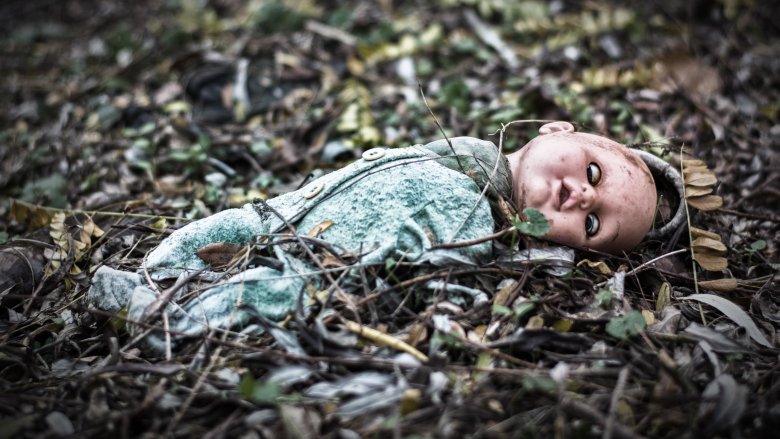Creepy Urban Legends That Turned Out To Be True
Urban legends are creepy, unsettling tales told late at night for nothing more than a knee-jerk sort of scare and a nervous laugh... right? Sure, some might have a cautionary moral attached to them, but they're often so implausible that there's no question as to what they are: a legend. No one actually believes them, or at least, they'll never admit that they'll be checking under the bed just to be sure.
But anyone who does some digging will find that not all of these urban legends are made up for kicks. Some are actually completely true, or at least based in some level of fact, and that includes some seriously terrifying stories. You've got your ax-wielding psychos and your secret tunnels sprawling under entire cities. Perhaps worst of all, the nutcase who lives in the woods and preys on unsuspecting children? He's real, and so are these other creepy urban legends.
Hippity hoppity, terror's on its way
There are a few stories surrounding the Bunny Man Bridge in Fairfax County, Virginia. According to one, the area was home to a disturbed teenager who put on a bunny costume before hanging himself from the overpass. In standard urban legend fare, he haunts the bridge and disembowels trespassers with an ax.
Brian A. Conley, the historian-archivist at the Fairfax County Public Library, found that the Bunny Man has a basis in truth. Conley says the legend is actually told all over the Virginia, Maryland, and D.C. area. The whole region echoes with tales of a man in a white bunny suit, wielding an ax and either destroying property, threatening kids, or killing innocent victims.
That was enough to make him wonder if there was something to it, and when he started combing through newspapers, he found the origins of the tale. In 1970, an Air Force cadet named Robert Bennett reported being in a car with his fiancee when a man in a white bunny suit jumped out of the bushes, yelled at them, and hurled a hatchet through the car window. They weren't hurt, but two weeks later a security guard came across the same Bunny Man, hacking away at the roof supports of a new house. There was a major investigation, but police never found out who was in the costume, and he never appeared again. The tales grew from there, because there's just something haunting about a man in a bunny suit.
Mom said those games were bad for your eyes
Gamers know the story. It starts in 1981, when an all-black game cabinet labeled simply "Polybius" appeared in arcades around Portland, Oregon. The game started having some strange effects on people who played it, including anxiety, seizures, and night terrors. Allegedly, there were even several suicide attempts among Polybius players. As if that wasn't creepy enough, Mental Floss says mysterious men in black were rumored to come to collect data from the machine every few weeks until it disappeared. There were whispers of MKUltra and other top secret government experiments, and even though researchers haven't found Polybius, they have found something eerily similar.
Skeptoid's Brian Dunning took a look at the legend, and found that while Polybius isn't real, the stories surround it are true. Several gamers in the Portland area did suffer from stomach issues and migraines after playing Asteroids and Tempest. The stories spread, became legend, and were supported by the very real cases of epileptic seizures triggered by other games.
And those rumors of men in black? True. At the same time that the kids fell sick, federal agents were investigating operators using arcades as fronts for gambling machines. Part of their surveillance was going around and documenting high scores in hopes of identifying witnesses, and the raids themselves meant going in and tearing apart games to see if they had been illegally modified. So, while Polybius wasn't real, the events surrounding it actually were.
The escape route for revolutionaries and inquisitors
For generations, residents of the Mexican city of Puebla have told their children and grandchildren the legends of a network of tunnels running back and forth beneath their feet. According to RT, the legends were as mysterious as they were varied, with historians adding that storytellers were quick to add that no living person knew where they were... or had ever seen them. There are stories claiming they were once used by revolutionaries, royalty, or people fleeing persecution and the Inquisition.
It sounds like something parents would tell their kids to make them even more afraid of the monsters under their beds, but in 2014, workers laboring on a massive underpass project broke through and discovered a dam and tunnel. Archaeologists took over, and concluded that it was just a small section of approximately seven miles of tunnels under the city. Al Jazeera says different sections were built at different times, as far back as the 16th century and as recent as the 19th. More sections were opened in 2016, but archaeologists say they're still unsure as to who started building them or why.
Splish, splash, that rat's taking a bath
This one is most common in big cities like New York, but you can find variations on it all over. Rats live in the sewers, the stories go, and it's entirely possible that one will, at some point, swim up some pipes and end up in someone's toilet. The lucky people will just open the lid to find a rat treading water there. The unlucky ones will be sitting on the toilet when it happens.
It sounds unlikely — that's a lot of swimming and it's a long way for a rat to hold their breath — but it's completely and terrifyingly true. The Seattle Times even ran a 2016 piece warning readers what to do when a rat made an appearance in their toilets (squirt in some dish soap to break the water's surface tension, then flush it away — it'll head back the way it came). And it happens way more than anyone would think. The King County Public Health Department answers between 50 and 80 rat-in-toilet occurrences each and every year.
Experts say the rats are trying to get into a kitchen or drain where they smell food, but since the toilet is the easiest access to a home, that's usually where they pop up. Health officials say the best thing to do is clean drains regularly, but they also add that rats can show up in a toilet anywhere, anytime, during any season.
Geronimo!
Here's another pretty familiar urban legend with a healthy dose of cautionary tale thrown in. It involves a man plummeting to his death outside the building where he works. It turns out the man was a lawyer who was awfully fond of demonstrating just how strong the windows in his building were by throwing himself at them, dozens of floors up. One day, the window breaks and that's it for the unfortunate, overconfident attorney. Who would do that?
Torontoist says this man was real, his name was Garry Hoy, and he had a weird habit of "bodychecking the windows of his office at Toronto's TD Centre." On one July day in 1993, he did it in front of a group of visiting students. Then, he did it again. The window popped out of the frame, and Hoy popped out of the building. He fell 24 stories, and while it's unclear exactly why he thought any of this was a good idea, it did have consequences for his coworkers. Snopes says his firm, Holden Day Wilson, closed three years after the incident, in part due to debt and in part due to an inability to recover from the tragedy.
A boogeyman in an abandoned asylum? Where else would he live?
According to The Lineup, the basics of this tale were simple: Cropsey was rumored to be the madman who lived in the woods of Staten Island and hunted misbehaving children. He was said be an escaped patient from a local institution, with a hook for a hand that he would use to drag his prey back to the ruins of an old tuberculosis sanitarium. Parents would threaten their children with abduction by Cropsey if they didn't behave. Whether the parents knew it or not, Cropsey was terrifyingly real.
The Willowbrook State School closed in 1987, having been the subject of an infamous 1972 expose by Geraldo Rivera. Rivera's 1972 investigation came seven years after Robert Kennedy condemned the institution in 1965, calling it a "snake pit." At that time, it was home to around 6,000 developmentally challenged individuals — 2,000 residents over capacity. It wasn't long after Willowbrook's closure, The New York Times reports, that former employee Andre Rand was arrested in connection with several disappearances. He was ultimately convicted after authorities found the body of 12-year-old Jennifer Schweiger buried in a shallow grave on the grounds of the institution.
Rand was ultimately linked to other disappearances, says NPR, but has steadfastly maintained his innocence. They also note that he was convicted in spite of a lack of physical evidence. Some don't believe he was the killer at all, but the fact remains — someone was.
You can tell a lot about a person by their internet handle
Anyone who was online during the early days of the internet probably remembers seeing forwarded emails warning about someone with the screen name "Slavemaster." Snopes says the emails were pretty straightforward: if someone with that screen name reached out, he should be avoided at all costs. Behind the screen, it was said, was a man looking to convince unsuspecting women to meet him in real life so he could kill them.
Sound unlikely? It was 100 percent true, and his name was John Edward Robinson, Sr. Vanity Fair says those at his church knew him as a devoted family man, neighborhood activist, and brilliant entrepreneur. Local authorities apparently knew he had once been convicted of being a con artist, but no one suspected he had an apartment just across the Missouri border where he kept the women he lured into meeting him.
Upon investigation, it was discovered he had a long history of generally horrible behavior before he even adopted his "Slavemaster" identity. He was ultimately linked to the disappearance of a number of women, including a Polish college student and a 27-year-old home care nurse. Finally, a 34-year-old woman he targeted called the police. When they searched his home, they found bodies sealed in 55-gallon metal barrels. Robinson had beaten his victims to death, and although it's unclear just how many women he murdered, police did find more bodies that he'd been keeping for years.
What's that smell?
The story starts with someone settling into a hotel room and noticing a strange smell. They might complain, they might not, but they always spend a few days in the room before the smell gets so unbearable they investigate fully. It's only then they find the dead body under the mattress.
This isn't just true, it happens with terrifying regularity. According to Snopes, it's happened in 1982, 1987, 1988, twice in 1989, twice in 1994, 1996, 1999, 2003, and 2010. Each time, guest complaints led to a complete search of a hotel room and the discovery of a dead body.
The stories are surprisingly varied. The first body was Gary Smith, a car thief poisoned and strangled by his associates, then left under the bed of a New Jersey motel room that was rented about four times before he was found. The two bodies discovered in 1989 were the work of the same killer, Jerry Lee Dunbar. He left 27-year-old Deirdre Smith under the floor of a motel room and 29-year-old Marilyn Graham under the bed of an Econo Lodge. The two separate incidents in 1994 both involved German tourists. In 2003, a man spent three nights in a Kansas City room before the smell became so unbearable he checked out. When the room was cleaned, a man in "an advanced stage of decomposition" was found under the mattress.
Not all monsters are heartless
Urban legend says there's a horribly disfigured creature that wanders the forests and highways around Pittsburgh. Sometimes he's called the Green Man. Sometime's he's called Charlie No-Face. Thrillist says sometimes, he's even called the Monster of Beaver County. That's awful, because he was actually a very sweet man named Ray Robinson.
In 1919, eight-year-old Robinson had an accident that changed his life forever. He was climbing a trolley trestle when he touched a live power line and was electrocuted. He lost one hand, and his face was, for lack of a better word, melted. He grew up incredibly isolated and at night, he liked to walk the local highways.
Even into the 21st century, teens cruise the highways looking for the Green Man. But those who grew up in the area in the 1960s actually found him. Some were incredibly cruel to him, and others made a friend who changed their lives. Robinson liked to chat with the kind ones, talk baseball, and drink beer. He would never accept one that had been opened for him, though, because of one incident where someone had filled a bottle with urine.
Documentary writer Tisha York interviewed hundreds who met him, and summed him up like this: "People were just so cruel to him, and he never understood why... underneath it all was this beautiful, kind man." Robinson died in 1985, but his legend lives on.
Souvenirs from your trip abroad
Here's the gist: someone goes on vacation, then comes back and starts suffering severe headaches or earaches not long after. The cause? Bugs crawled the hapless vacationer's ears and nested in their brain.
Sorry, but this one isn't just true, it's happened a couple times. In 2013, Rochelle Harris returned to Britain from a holiday in Peru. When she started hearing scratching noises, she was a little worried. It got worse when the headaches started, and when she woke up with a mysterious liquid on her pillow, she decided to seek medical attention for what she thought was an ear infection. The truth? A fly she'd swatted out of her ear in Peru had laid eggs in her ear canal, and she was now home to a family of maggots. She needed surgery to remove them (via Reuters).
Then, in 2015, the Independent reported that Yadira Rostro underwent surgery after suffering from nine months of headaches. The cause? Tapeworm eggs in her brain. Doctors were pretty sure she picked up the parasite when she was in Mexico two years prior, and that it had traveled through her bloodstream and into her brain, where it laid eggs. Good luck enjoying another vacation!
Today's special: people
It's part urban legend, part crime drama trope. It's the one about the serial killer (or assassin, or cheater) who almost gets away with murder by feeding the bodies of his victims to his pigs. It's used in a lot of fiction, and it's happened a lot in real life.
In 2013, The Telegraph reported on a police investigation from southern Italy. According to taped phone conversations, Francesco Raccosta was murdered during a mafia turf war, then his body was fed to pigs. In 2015, USA Today reported Susan Monica had been found guilty of not only murdering two men (one in 2012 and one in 2013), but of disposing of the bodies by feeding them to her pigs.
But the idea goes back even further, to one of Canada's most infamous serial killers. Robert Pickton was arrested in 2002 for the murders of 26 women over the course of around 6 years. Most were snatched off the streets of Vancouver (via The Canadian Encyclopedia), and according to the testimony of those who knew him, he bragged of killing dozens of women and disposing of the bodies by feeding them to his pigs. Thousands of DNA samples were ultimately recovered from his farm, and according to a jailhouse confession, the only thing he regretted was being stopped just one victim short of 50. Later, says The Seattle Times, Pickton would claim he was framed.
Gee, those Halloween decorations look realistic...
Sometimes, the most horrifying Halloween stories are the true ones. Take, for instance, the tale of a very realistic-looking decoration. It's so realistic, in fact, that neighbors eventually call the police to come and check it out, and it's only after days of sitting in plain view that someone realizes it's an actual body.
It's happened a few times. The first incident was in 1990, when 17-year-old Halloween hayride worker Brian Jewell accidentally hanged himself along the route of the attraction. He was supposed to be portraying a hanged man when he was strangled by the prop rope (via Orlando Sentinel).
Then, in 2005, NBC News reported that a woman committed suicide by hanging herself from a tree along a fairly busy Delaware roadway. She was believed to have done it late on a Tuesday night or early on a Wednesday morning, and the people who saw her Wednesday thought it was a Halloween prank. Police were called hours later, and only then did they discover it wasn't a prank at all.
And finally, the LA Times reported that in 2009, Mostafa Mahmoud Zayed sat on the balcony of his apartment for days after being shot in the face. Neighbors had noticed his body, but didn't call the police because they thought it was simply a Halloween decoration.












